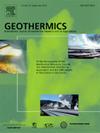Shallow geothermal subsurface temperature contour mapping aided by numerical reservoir modelling; Taupō, New Zealand
IF 3.9
2区 工程技术
Q3 ENERGY & FUELS
引用次数: 0
Abstract
Geothermal resources in Taupō town, New Zealand, are integral to the region’s sustainable energy use, yet understanding shallow subsurface temperature distribution remains challenging due to scattered data. This study addresses this gap by collecting and analysing data to create refined temperature contour maps for geothermal resource management and utilisation strategies.
Data from 279 domestic bores (wells) were collected for this study and supplemented with older data from publicly available sources. These data were used to develop initial contour maps, which were subsequently improved through kriging interpolation and the integration of artificial temperature-depth profiles to address gaps in data coverage. A numerical reservoir model simulated shallow subsurface thermal conditions, allowing contour maps adjustments in areas with limited data.
Results indicate distinct temperature patterns between the cooler Northern Tauhara aquifer and the Southern Tauhara aquifer, where hot water is abundant for direct-use applications. Findings were validated using mock-up bores and comparing their temperature profiles to residents' observations from their domestic bores. A strong correlation was observed between the artificially generated temperature profiles and those observations, confirming the map’s qualitative reliability.
Despite data sparsity and interpolation limitations in some regions necessitating cautious interpretation of the contour maps, this study provides insights that can inform decision-making process for the sustainable utilisation of Taupō’s shallow geothermal resources, including temperature profile predictions within the study area.
油藏数值模拟辅助的浅层地热地下温度等值线图陶普岛,新西兰
新西兰陶普镇的地热资源是该地区可持续能源利用不可或缺的一部分,但由于数据分散,了解浅层地下温度分布仍然具有挑战性。本研究通过收集和分析数据,为地热资源管理和利用策略创建精细的温度等高线图,解决了这一差距。本研究收集了279口国内井眼(井)的数据,并辅以公开来源的旧数据。这些数据用于开发初始等高线地图,随后通过克里格插值和人工温度-深度剖面的整合来改进等高线地图,以解决数据覆盖的空白。数值油藏模型模拟浅层地下热条件,允许在数据有限的地区调整等高线图。结果表明,在温度较低的北陶原含水层和热水充足的南陶原含水层之间存在明显的温度模式。使用模拟钻孔并将其温度曲线与居民从其国内钻孔观察到的结果进行比较,验证了研究结果。在人工生成的温度曲线和这些观测结果之间观察到很强的相关性,证实了该地图在质量上的可靠性。尽管某些地区的数据稀疏性和插值限制需要谨慎地解释等高线图,但本研究提供的见解可以为taupku浅层地热资源的可持续利用决策过程提供信息,包括研究区域内的温度剖面预测。
本文章由计算机程序翻译,如有差异,请以英文原文为准。
求助全文
约1分钟内获得全文
求助全文
来源期刊

Geothermics
工程技术-地球科学综合
CiteScore
7.70
自引率
15.40%
发文量
237
审稿时长
4.5 months
期刊介绍:
Geothermics is an international journal devoted to the research and development of geothermal energy. The International Board of Editors of Geothermics, which comprises specialists in the various aspects of geothermal resources, exploration and development, guarantees the balanced, comprehensive view of scientific and technological developments in this promising energy field.
It promulgates the state of the art and science of geothermal energy, its exploration and exploitation through a regular exchange of information from all parts of the world. The journal publishes articles dealing with the theory, exploration techniques and all aspects of the utilization of geothermal resources. Geothermics serves as the scientific house, or exchange medium, through which the growing community of geothermal specialists can provide and receive information.
 求助内容:
求助内容: 应助结果提醒方式:
应助结果提醒方式:


